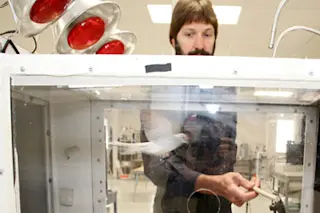The aerodynamics of nature’s greatest hovercraft, the nectar-loving hummingbird, has long eluded scientific explanation. The tiny bird can buzz above a flower for minutes just as some insects do, and even fly backward and sideways, outmaneuvering most other birds. Now biologist Bret Tobalske of the University of Montana Flight Laboratory and his colleagues have documented the hummingbird’s remarkable flying skills in unprecedented detail, rendering surprising insights into how the bird stays aloft.
To catch the bird in action, Tobalske and his team employed an unusual visualization technique involving a clear plastic box, high-speed military cameras originally designed to document ballistics, a laser, and a few spritzes of olive oil.
In their experiments, a hummingbird is set loose in one side of the box. As it darts for sugar water on the other side, it rapidly flaps its wings, flying through a laser-illuminated fog of vaporized olive oil particles. Cameras, meanwhile, ...















